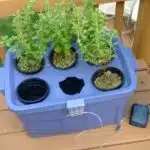As the temperatures drop and the leaves begin to fall, it is time for gardeners to start preparing their gardens for the winter months. Winterizing a garden is essential to ensure that all plants survive harsh weather conditions and are ready to grow again in spring. Taking the necessary steps to protect your garden during winter will prevent plant damage, disease, and pest infestations.
Winterizing a garden involves several crucial tasks that need to be done before the first frost arrives. The process includes protecting plants from cold temperatures, windburn, and snow accumulation while also preventing soil erosion and nutrient loss. In this article, we will discuss effective strategies for winterizing your garden, including protective coverings, pruning techniques, mulching methods, and soil amendments. By following these recommendations, you can ensure that your garden remains healthy throughout winter and is ready for a successful growing season in spring.
Understanding The Importance Of Winterizing Your Garden
The importance of winterizing your garden cannot be overstated. It is a critical step in maintaining the health and vitality of your plants, protecting them from the harsh conditions of winter. Without proper preparation, your garden may suffer significant damage or even death. However, by taking this essential step, you can reap many benefits and avoid the risks associated with neglect.
One of the primary benefits of winterizing your garden is that it ensures that your plants will survive through the cold months ahead. By providing them with adequate protection, you can prevent frost damage and keep them healthy until spring arrives. Additionally, winterizing can help to reduce disease and pest problems, which tend to thrive in damp and humid environments. This means that you’ll have fewer issues to deal with when it’s time to start gardening again in the spring.
On the other hand, failing to winterize your garden comes with several risks. For one, it leaves your plants vulnerable to harsh weather conditions that can cause dehydration or frost damage. Moreover, leaving dead plant debris in your garden over the winter provides a perfect breeding ground for pests and diseases that can spread rapidly come springtime. Therefore, taking steps to winterize your garden is an essential aspect of responsible gardening and is necessary for ensuring optimal plant health all year round.
To prepare your garden for the cold months ahead, there are several important steps you need to take. These include cleaning up any fallen leaves or debris from your lawn and beds, cutting back any dead or overgrown branches on trees or shrubs, mulching around perennials and young trees to protect their roots from freezing temperatures, and covering tender plants with burlap or other protective material to prevent frost damage.
Preparing Your Garden For The Cold Months Ahead
With the understanding of why winterizing your garden is important, it’s time to move on to preparing your garden for the cold months ahead. Best practices include clearing out debris and dead vegetation, covering plants with mulch or blankets, and protecting delicate plants by moving them indoors or to a sheltered area.
One common mistake many gardeners make is waiting too long to prepare their garden for winter. It’s important to start early, ideally before the first frost hits. This gives ample time to complete all necessary tasks without rushing and potentially damaging plants.
When it comes to tools needed for winterizing your garden, there are plenty of budget-friendly options available. Rakes, pruners, and bags for collecting debris can all be found at affordable prices at most gardening stores. Additionally, using fallen leaves as mulch is not only cost-effective but also eco-friendly.
Clearing out debris and dead vegetation is an essential step in preparing your garden for winter. It not only helps prevent disease from spreading but also allows air and sunlight to reach the soil. In the next section, we will delve deeper into this crucial step and discuss techniques for effectively clearing out debris and dead vegetation.
Clearing Out Debris And Dead Vegetation
Once you have harvested your crops and cut back any spent perennials, it’s time to clear out debris and dead vegetation to prepare your garden for winter. Removing weeds is a crucial step in this process as they can harbor pests and diseases that could harm next year’s plants. Pull them out by hand or use a hoe to sever the roots just below the soil surface.
Clearing out fallen leaves is also important as they can smother plants, block light, and create a moist environment that encourages fungal growth. You can rake them up and add them to your compost pile, or shred them with a mulching mower and use them as a protective layer over your garden beds. Just be sure not to leave any large piles of leaves on the lawn as they could damage the grass underneath.
By removing debris and dead vegetation from your garden, you’ll not only create a tidier appearance but also promote healthier plants in the long run. Now that you’ve cleared out the clutter, it’s time to move onto pruning trees and shrubs. This will help shape their growth, remove any damaged or diseased branches, and encourage new growth come springtime.
Pruning Trees And Shrubs
After clearing out debris and dead vegetation from your garden, it is time to move onto pruning trees and shrubs. Think of pruning as a haircut for your plants, helping them maintain their shape and encouraging healthy growth. However, just like going to the hair salon, it’s important to have the right tools for the job.
There are several types of pruning tools you can use such as hand pruners, loppers, and pruning saws. Hand pruners are best for smaller branches while loppers can handle thicker ones. Pruning saws are ideal for larger tree limbs or overgrown shrubs. It’s essential to keep your tools sharp as dull blades can damage your plants.
The best time to prune depends on the specific plant species in your garden. In general, it’s best to prune in late winter or early spring before new growth begins. However, some plants such as flowering shrubs should be pruned after they bloom in order to avoid cutting off next year’s buds. By properly pruning your trees and shrubs at the right time with the appropriate tools, you’ll improve their overall health and appearance. Next up: dividing and transplanting perennials.
Dividing And Transplanting Perennials
Dividing and transplanting perennials is a necessary task to maintain the health and vigor of your garden. Best practices for dividing your plants include choosing the right time of year, selecting healthy plants, preparing the new location, and ensuring proper watering after transplantation.
Choosing the right time of year is crucial when dividing and transplanting perennials. It’s best to divide plants in the spring or fall when temperatures are cooler, and there’s less stress on the plant. Selecting healthy plants is also essential; look for plants that have strong stems, healthy foliage, and no signs of disease or pests.
Preparing the new location for your perennials is equally important. Choose a location with well-draining soil that receives adequate sunlight for the specific plant species you’re transplanting. Water your newly transplanted perennials immediately after planting to ensure they establish roots in their new environment.
Protecting plants with protective coverings can help prevent damage from harsh winter weather conditions. By providing an extra layer of insulation, you can help protect against frost heave or freezing temperatures. There are many options available such as burlap wraps, mulch covers, or even plastic sheeting depending on what works best for your particular garden needs.
Protecting Plants With Protective Coverings
One effective way to protect your garden during the winter season is by using protective coverings. These coverings serve as a barrier between your plants and the harsh winter elements, such as snow and frost. Protective covering alternatives include burlap sacks, blankets, tarps, and row covers.
When choosing the right material for your garden, it is important to consider several factors. The first factor is the size of your garden. You should choose a material that can cover your entire garden without leaving any gaps or openings. The second factor is the type of plants in your garden. Some plants are more sensitive to cold weather than others, so you may need a thicker or heavier material to protect them.
Another factor to consider is the durability of the material. You want a protective covering that can withstand strong winds and heavy snowfall without tearing or ripping. Lastly, you should also consider the cost of the material. While some materials may be more expensive than others, they may also offer better protection and last longer.
Transitioning into the subsequent section about building a cold frame or hoop house, it is important to note that these structures provide an even greater level of protection for your plants during winter months. By creating an enclosed space with insulated walls and roof, you can control temperature and humidity levels for optimal plant growth. Let’s explore how you can build these structures in further detail.
Building A Cold Frame Or Hoop House
Building a Cold Frame or Hoop House is a great way to extend your growing season in the winter months. When it comes to DIY vs. store bought cold frames, both options have their pros and cons. A DIY cold frame can be customized to fit your specific needs and can be made from materials you may already have on hand, making it a cost-effective option. However, store-bought cold frames may have better insulation properties and be more durable in harsh weather conditions.
Choosing the right materials for a hoop house is crucial for its success in protecting your plants from the elements. The frame of a hoop house can be made from PVC pipes or metal tubing, with plastic sheeting used as the covering material. It’s important to choose sturdy materials that can withstand heavy snow loads and high winds. Additionally, the plastic sheeting should be UV resistant to prevent it from deteriorating quickly.
To enjoy your cold frame or hoop house during the winter months, consider adding some creative touches that will make your gardening experience enjoyable even when temperatures drop below freezing. Here are three ideas:
- Add a heat source such as an electric heater or heated soil cables.
- Install shelves inside to create additional growing space.
- Paint the exterior of your structure a bright color to add some cheer during dreary winter days.
With these tips in mind, building a cold frame or hoop house can be an enjoyable project that yields bountiful rewards come springtime. In the next section, we will explore another method for winterizing your garden: using mulch to insulate plants and soil.
Using Mulch To Insulate Plants And Soil
Mulching is an essential step in winterizing your garden. Mulch is a layer of material applied to the soil surface around plants, acting as an insulating blanket that helps to protect the plants and soil from temperature fluctuations. Mulching benefits include retaining moisture in the soil, preventing weed growth, and regulating soil temperature.
There are two types of mulch: organic and inorganic. Organic mulches are made from natural materials such as leaves, straw, or bark chips. They gradually break down over time, providing nutrients to the soil. Inorganic mulches such as rocks or gravel do not break down but can still provide insulation for the plants and help retain moisture.
When choosing a mulch for your garden, consider the type of plant you are protecting and the climate in which you live. For example, tender plants may require thicker layers of mulch to survive harsh winter conditions. Additionally, different types of organic mulches may be more appropriate for certain plants than others.
Incorporating mulching into your winterization routine can ensure that your garden thrives despite colder temperatures. However, it’s important to remember that while mulch can provide insulation for your garden beds and keep them healthy throughout the winter season, it’s only one part of a comprehensive plan to ensure that your garden remains productive year-round. In our next section, we’ll explore how fertilizing your garden for winter can help prepare for next year’s growing season.
Fertilizing Your Garden For Winter
As the weather starts to cool down and your garden begins to enter dormancy, it’s essential to provide your plants with the nutrients they need to survive the winter. Fertilizing your garden during this time is crucial in ensuring that your plants will be healthy and ready for new growth when spring arrives. Here are some tips on how you can fertilize your garden for winter:
One way to fertilize your garden for winter is by applying compost. Compost is an excellent source of organic matter that can improve soil structure and provide nutrients to your plants. Spread a layer of compost over the soil surface, then mix it into the top few inches of soil. This will help improve soil fertility while also providing a good environment for beneficial microorganisms.
Another option is to use organic fertilizers. These are derived from natural sources such as animal manure, bone meal, blood meal, and fish emulsion. Organic fertilizers release their nutrients slowly over time, providing a steady supply of food for your plants throughout the winter months. They also help improve soil health by promoting beneficial microorganisms and improving soil structure.
To get the most out of your fertilizer application, make sure you apply it at the right time. Apply compost in late fall before the ground freezes or early spring just before planting. For organic fertilizers, apply them in mid-fall when temperatures have cooled down but before the ground has frozen.
- Use a balanced fertilizer with equal amounts of nitrogen, phosphorus, and potassium.
- Avoid using synthetic fertilizers as they can harm beneficial microorganisms in the soil.
- Mix fertilizer into the top few inches of soil around each plant.
- Water thoroughly after applying fertilizer.
- Apply only enough fertilizer as recommended; too much can damage plants and leach into groundwater.
By following these tips and being mindful of what you put into your garden during winter months, you’ll be able to ensure that your plants are well-nourished and healthy come springtime. In the next section, we will discuss how to prepare your soil for spring planting.
Preparing Your Soil For Spring Planting
Testing the soil is an essential first step in preparing your garden for spring planting. A soil test will help determine the pH level of your soil and identify any nutrient deficiencies that need to be addressed. Testing can be done through a local garden center or by purchasing a home testing kit. Once you have identified any issues, you can adjust the pH levels and add necessary nutrients to ensure optimal growing conditions.
Adding nutrients to your soil is critical for healthy plant growth. Organic matter such as compost, manure, and leaf mold are excellent sources of nutrients that can be added to your garden during the winter months. These materials improve soil structure, increase water retention, and provide essential micronutrients for plants. Additionally, adding fertilizers containing nitrogen, phosphorus, and potassium can boost plant growth.
Incorporating organic matter into your soil is an ideal way to add nutrients naturally while improving overall soil health. However, it’s crucial not to overdo it when adding amendments like compost or manure. Too much organic matter can cause imbalances in the soil ecosystem leading to nutrient deficiencies or toxicities. Therefore, it’s best to follow recommended application rates based on garden size and type of amendment used before planting come springtime.
As you prepare your garden for spring planting by testing the soil and adding necessary nutrients, don’t forget about protecting it from frost and windburn. By taking preventive measures now such as mulching around plants or covering with protective fabric when temperatures drop below freezing points can safeguard against damage caused by harsh weather conditions later on down the road.
Protecting Your Garden From Frost And Windburn
As winter approaches, the garden is vulnerable to frost damage and windburn. Frost damage occurs when the water inside plant cells freezes and expands, causing the cells to burst. This leads to discoloration, wilting and eventually death of the plant. Windburn exacerbates frost damage by drying out plants and intensifying the cold temperatures. It is therefore important to take steps to protect your garden from these harsh conditions.
One way of preventing frost damage is by choosing the right protective covering for your plants. Protective covers should be sturdy enough to withstand strong winds but also lightweight enough not to crush delicate plants. Materials like burlap, blankets or row covers are good options as they provide insulation while allowing air circulation. It is important to secure the covers well as any gaps can allow cold air in.
To further protect your garden from windburn, consider creating a windbreak using materials like fabric or fencing. This will help reduce the impact of strong winds on your plants, keeping them healthy throughout winter. Additionally, you can move potted plants indoors or into a sheltered area where they are less exposed.
- Covering your plants with mulch can help insulate their roots.
- Watering plants adequately before freezing weather arrives will help them better resist frost.
- Pruning dead branches helps avoid them breaking under heavy snowfall.
- Removing weeds and other debris from around the base of your plants reduces harboring places for pests that might kill your plants.
- Fertilizing in late fall will lead to stronger root systems that are more resistant to frost damage.
By taking these measures, you can ensure that your garden remains healthy during winter months. Protecting it from harsh conditions ensures that it will thrive once spring returns, allowing you to enjoy its beauty all year round. Next step is watering your plants appropriately so they remain healthy even during extreme temperature changes without overwatering them!
Watering Your Plants Appropriately
After taking measures to protect your garden from frost and windburn, it is important to ensure that your plants are being watered properly. Proper watering can help strengthen plants and protect them against extreme winter conditions. It is important to establish a watering schedule that meets the needs of your specific plants.
Before establishing a watering schedule, it is important to understand the water needs of your plants. Some plants may require more frequent watering while others may require less. In general, it is best to water deeply and infrequently rather than lightly and frequently. This allows for deeper root growth which helps plants withstand harsh weather conditions.
When establishing a watering schedule, consider factors such as soil type, plant species, and weather conditions. It is important to avoid overwatering as this can lead to root rot and other issues. On the other hand, underwatering can also be harmful to plants during the winter months. By understanding the specific needs of your garden and establishing a proper watering schedule, you can help ensure healthy growth throughout the winter season.
As we near the end of the gardening season, it’s important to prepare for next year by cleaning and storing garden tools properly. Neglecting tool maintenance can result in rust build-up or damage during storage leading to costly replacements in the spring. To avoid this, clean tools with soap and water before drying them thoroughly. Once dry, apply a light coating of oil or wax to prevent rusting. Store tools in a dry location such as a shed or garage away from moisture or extreme temperatures.
Transition: Now that we have discussed proper watering techniques for winterizing your garden, let’s move on to preparing for next year’s growing season by ensuring our garden tools are stored correctly.
Cleaning And Storing Garden Tools
As the gardening season comes to a close, it’s important to think about the care of your tools during the winter months. Proper storage and maintenance can extend their lifespan and ensure they’re ready to use when spring arrives.
Storing tools in a dry place is key to preventing rust and corrosion. Before putting them away, make sure they’re clean and free of any dirt or debris. Use a wire brush or sandpaper to remove any rust spots, then wipe them down with a cloth soaked in oil or WD-40 to protect against moisture.
Winter tool care doesn’t stop at storage. It’s also important to inspect your tools for any damage or wear that may need repair before next season. And don’t forget about sharpening blades, such as pruning shears and shovels, which will make them more effective when it’s time to get back into the garden.
As we prepare for colder weather, taking care of our gardening tools is just one aspect of maintaining an outdoor space. But there are other options for those who want to continue nurturing plants during the winter months. Consider exploring indoor gardening options as a way to satisfy your green thumb all year round.
Considering Indoor Gardening Options
Indoor gardening is an option for those who want to continue their gardening activities during the winter months. Indoor gardens can be set up in any convenient space, provided that there is adequate light and warmth. One of the main advantages of indoor gardening is that it provides a controlled environment where temperature, light, and humidity can be regulated.
Indoor vs outdoor gardening has its pros and cons. Outdoor gardening offers more space for plants to grow, but it is subjected to weather changes and pests. On the other hand, indoor gardening provides a controlled environment with fewer pest problems, but it may require additional lighting and heating equipment. It is important to consider which type of gardening suits your needs before starting your garden.
Container gardening vs hydroponics are two popular methods of indoor gardening. Container gardens are suitable for growing plants in soil or compost in pots or containers. Hydroponics, on the other hand, involves growing plants without soil by using nutrient solutions in water. Both methods have their advantages and disadvantages and should be considered based on what you want to grow and how much time you have to invest in caring for your plants.
As you begin considering indoor garden options, remember that monitoring your garden throughout the winter months is essential. Indoor gardens often require more attention than outdoor gardens because they are not exposed to natural elements like rain or sun exposure. Checking on soil moisture levels, providing adequate lighting, and regulating temperature are all key aspects of keeping an indoor garden healthy during the winter months.
Monitoring Your Garden Throughout The Winter Months
As the winter months approach, it is important to monitor your garden to ensure that it remains healthy and protected from the harsh weather conditions. A winter garden requires special care and attention in order to thrive when the warmer months roll around again. By taking a few simple steps, you can protect your garden and ensure that it continues to grow and flourish.
Winter garden care involves paying close attention to soil moisture levels, temperature fluctuations, and frost protection techniques. It is important to regularly check the moisture level of the soil in your garden during the winter months. This can be done by simply sticking your finger into the soil and feeling for dampness. If the soil is dry, add water as needed to keep it moist but not overly wet.
Frost protection techniques are also crucial for maintaining a healthy winter garden. One effective method is to cover plants with blankets or tarps on frosty nights. Another technique is to use mulch to insulate plant roots from cold temperatures. Additionally, consider using row covers or greenhouses to provide additional protection from frost and other extreme weather conditions.
- Check soil moisture levels regularly
- Cover plants on frosty nights
- Use mulch or row covers for added insulation
By monitoring your garden throughout the winter months and implementing these winter garden care techniques, you can ensure that your plants remain healthy and vibrant until spring arrives. With just a little bit of effort, you can maintain a beautiful outdoor space all year long without having to worry about losing any of your hard work due to harsh weather conditions.
Conclusion
Winterizing your garden is a crucial task for any gardener, as it helps your plants survive the harsh winter months and come back stronger in the spring. Proper preparation can mean the difference between a healthy and vibrant garden or one that struggles to recover.
To begin winterizing your garden, clear out any debris and dead vegetation, prune trees and shrubs, divide and transplant perennials, and water plants appropriately. Additionally, cleaning and storing garden tools properly can help prevent damage from snow or ice. For those who want to continue gardening during the winter, indoor gardening options are worth considering.
In conclusion, as a horticulturalist, I cannot stress enough the importance of winterizing your garden. While it may seem like a daunting task, taking these simple steps can ensure that your garden thrives year-round. Remember: “An ounce of prevention is worth a pound of cure,” so take the time to properly prepare your garden for the winter months ahead. Your plants will thank you come springtime!
Image Credits
- “Winter in Holland, Snow Garden, Zutphen – 0959” by HereIsTom (featured)





























